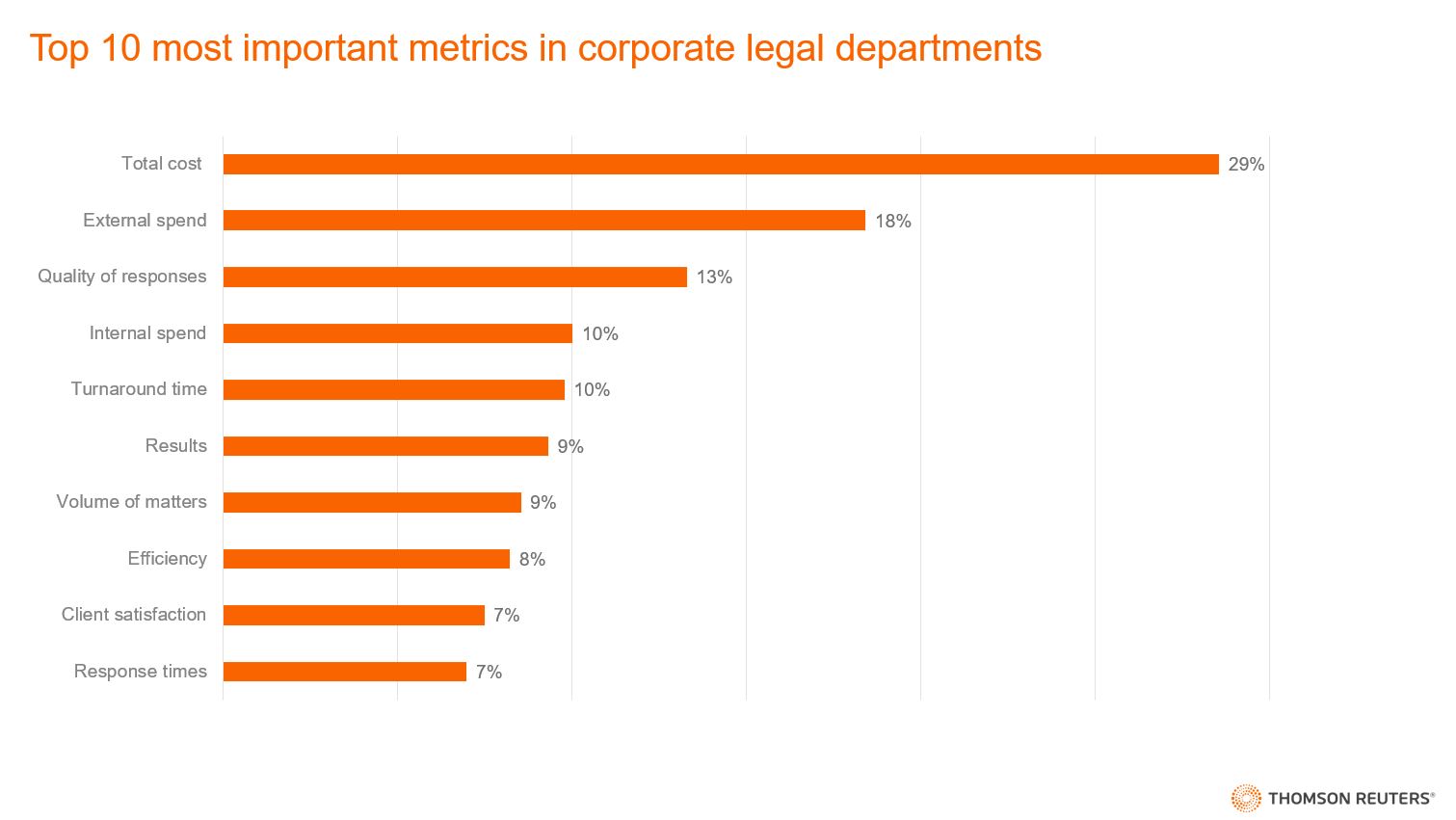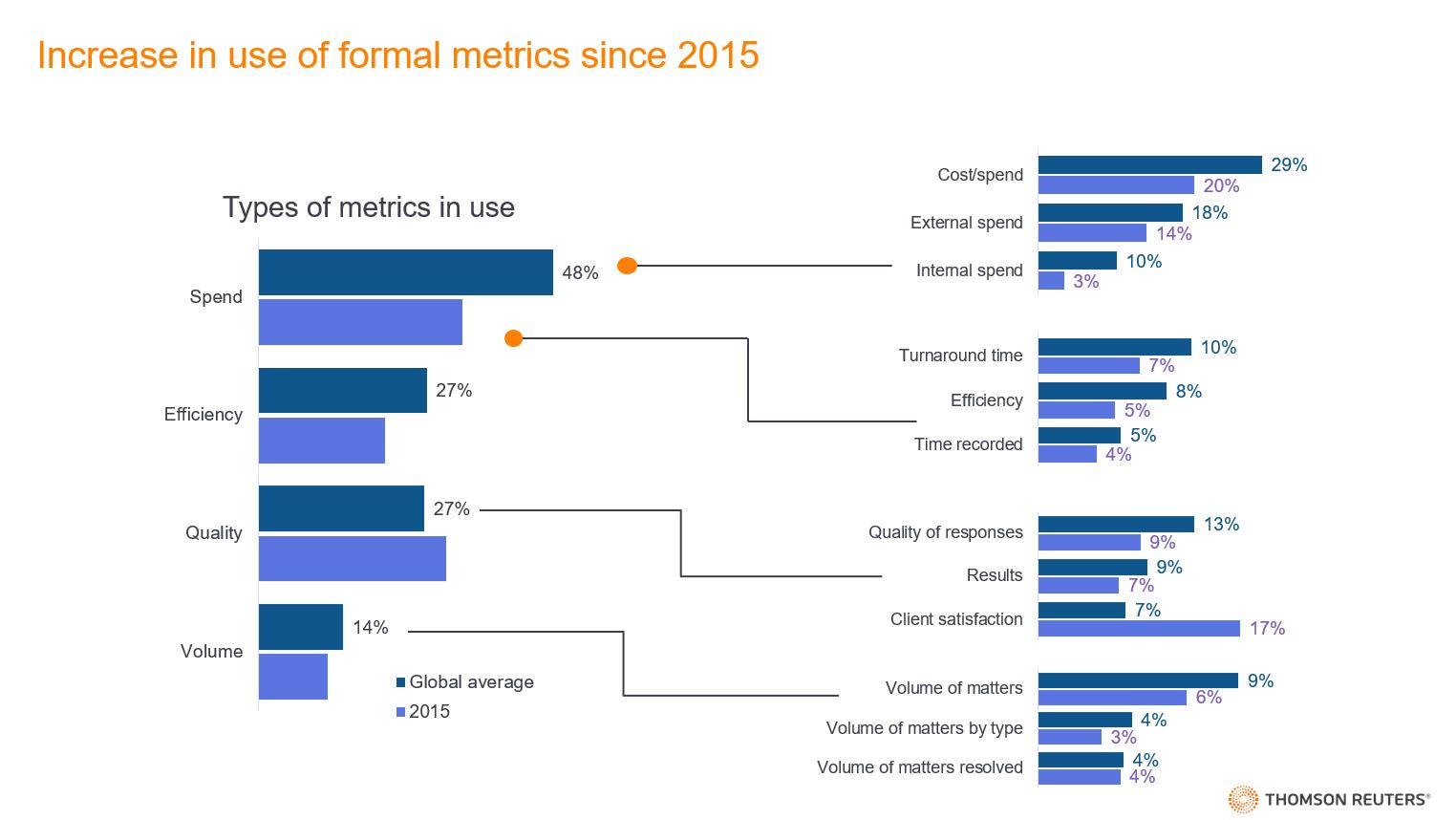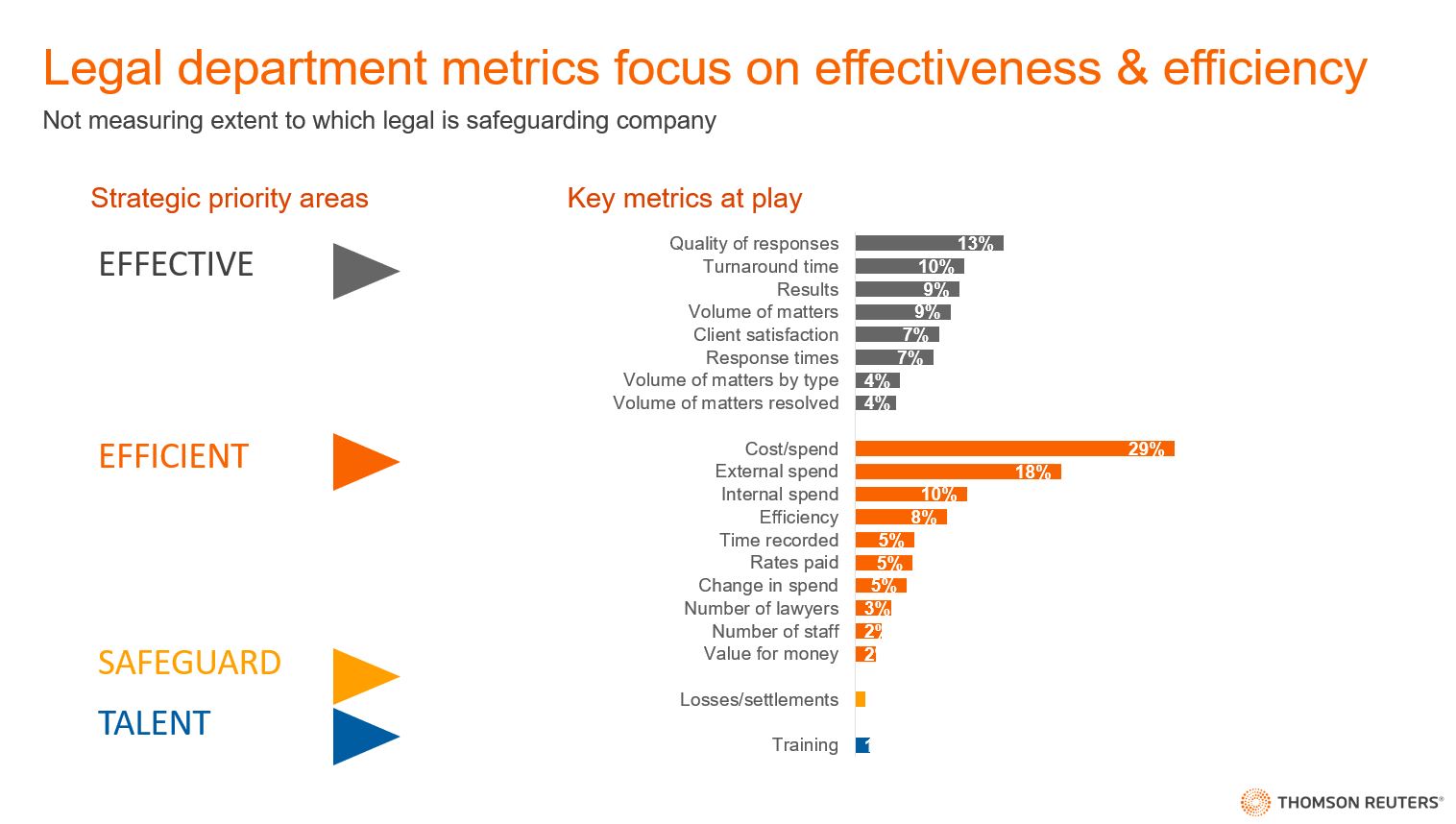How can corporate law departments use the right kind of measures and metrics to best monitor their progress and work toward their strategic priorities?
In our last article, we learned that the strategic priorities of corporate law departments fall into four broad areas: providing an effective service, doing it efficiently, proactively safeguarding the company against risk, and investing in the team for the long term. Now, we examine how corporate law departments are monitoring their progress and performance in line with these strategic priorities.
Overall, there is a mismatch between what law departments are trying to achieve (their strategic priorities) and what they are measuring. We’ll explore areas where these departments could better measure the metrics that matter.
The use of metrics in law departments
A full 90% of law departments in those companies with $1 billion or more in revenue are using formal metrics to help them run their department operations. That means that 1 in 10 is not; however, the good news is that compared to 2015, progress is being made. At that time, it was 4 in 10 (25%) of law departments that had no formal metrics in place.
Overall, the most common metrics used by corporate law departments relate to spend and include: total cost (used by 29%); external spend (18%); and internal spend (10%).
 There are some interesting differences when this data is looked at by industry sector. The more traditional, primary industries — such as Natural Resources, Agribusiness, Automotive, and Manufacturing — are less likely to have metrics. However, more heavily regulated sectors — such as Finance, Healthcare, Pharmaceuticals, Retail, and Real Estate — are more likely to be using metrics.
There are some interesting differences when this data is looked at by industry sector. The more traditional, primary industries — such as Natural Resources, Agribusiness, Automotive, and Manufacturing — are less likely to have metrics. However, more heavily regulated sectors — such as Finance, Healthcare, Pharmaceuticals, Retail, and Real Estate — are more likely to be using metrics.
Compared to 2015, more law departments also are measuring spend and efficiency areas with the biggest proportional shifts around the measurement of internal spend (more than three times more departments measuring this now) and efficiency (almost twice as many).
Surveyed about their priorities, corporate law department leaders underscored how these measurements work in practice. “Efficiency in a sense of how [we can manage] the workload with the number of FTE [full-time equivalent employees] we have” is important, said one department leader. “So the efficient employment of resources, that’s the prime focus now.”
When it comes to quality measurement, departments were previously more focused on perhaps informal stakeholder feedback and satisfaction; now the focus is on quality of responses and results as much as feedback, and many departments are measuring this in a more formal way.
“We track the number of lawyers, the number of paralegals, we track internal legal spend, we track external legal spend, we track, obviously the ratio between the two, and we track customer or what we call business alignment survey results,” said another department leader.
Metrics that matter
Looking back to the strategic priorities that corporate law departments now are focused on, it’s clear there is a mismatch between what departments are trying to achieve versus what they are actually measuring. To optimize performance across all areas, it’s important to measure what matters — after all, you can’t manage what you don’t measure.
“We monitor spend, diversity and inclusion, the law firms we use, matter level, and the hourly rates that have been agreed,” said one department head. Others added that their department monitors the entire matter-level cycle, outside counsel spend, client satisfaction, timeliness of responses, and adherence to internal and external deadlines.
Law department metrics tend to focus on effectiveness (quality of responses, turnaround time, results) and efficiency (cost, external and internal spend), which can be good because these are two of the four areas of strategic priority that were initially outlined by general counsel. However, most departments are not measuring the extent to which it is safeguarding the company against risk or building a team for the future. Less than 1% noted that they are measuring losses or settlements and similar percentage have targets around the up-skilling of the internal team.
These are big areas of strategic importance for law departments in fulfilling their function of protecting the company from risk, and also in shifting perceptions of the department’s value in the eyes of the organization, moving them from being seen as a reactive cost center to a proactive business partner that adds true value to the organization.
Some departments have made inroads to these types of metrics, indicating they measure such factors as the “reduction in the stock of lawsuits, average ticket of payment of lawsuits, and average time and satisfaction of internal clients with preventive service.” Others cited they were measuring how they reduced regulation and any negative reputational impact.
Of course, it can be tricky to prove the size of hit a company has missed thanks to the work of its law department. As a solution, these departments should consider tracking the positive actions that go toward this safeguarding effort, such as identification of risk versus impact. A good example is cybersecurity — the number of attacks or attempts that have been identified and prevented; or, in the case of reducing risk of employee disputes in large companies, tracking the number of employees who have completed new training.
 So, what is the right set of metrics to use? There is no single right answer here — this decision will depend on the company, the work, the goals, and, crucially, how the data the law department collects will be used in order to drive better performance.
So, what is the right set of metrics to use? There is no single right answer here — this decision will depend on the company, the work, the goals, and, crucially, how the data the law department collects will be used in order to drive better performance.
“In my previous company, we did have a system that, although information was input into it, it did not generate reports — and it is important that reports are generated so you can show the rest of the organization,” another department leaders said. “Other metrics involved the number of contracts generated, or the number of notifications received and answered. And all those types of reports are always good to have, but the most important one is the one that clearly determines judgments and probability of success.”
For corporate law departments, best practices include starting with a small number of key metrics that are easy to measure without too much extra effort — spend tends to be the winner here. Then, aim to have at least one key measure for each of the department’s stated objectives. The frequency of measurement may vary — some indicators, like spend, naturally run to a monthly cycle while others, such as internal satisfaction surveys, may be conducted once or twice a year or with the completion of every matter.
Reviewing results on a monthly, quarterly, and annual basis enable close monitoring against progress that allows department leaders to be nimble in making adjustments to ensure goals can be met. And finally, don’t let perfection be the enemy of good — it is better to have some indication of performance, even if slightly incomplete, than none at all.
It’s clear that law departments vary in level of sophistication using metrics, but the key is to start somewhere. After all, as one in-house counsel put it: “I wish I had better metrics. I wish I had better data… it’s helpful in making better decisions.”







